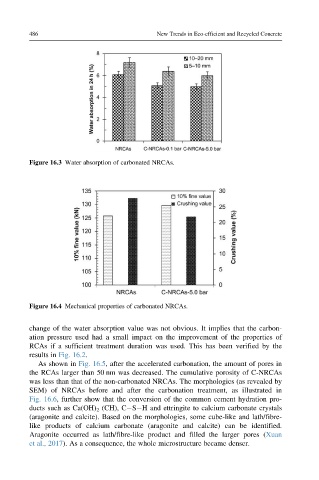Page 538 - New Trends in Eco efficient and Recycled Concrete
P. 538
486 New Trends in Eco-efficient and Recycled Concrete
Figure 16.3 Water absorption of carbonated NRCAs.
Figure 16.4 Mechanical properties of carbonated NRCAs.
change of the water absorption value was not obvious. It implies that the carbon-
ation pressure used had a small impact on the improvement of the properties of
RCAs if a sufficient treatment duration was used. This has been verified by the
results in Fig. 16.2.
As shown in Fig. 16.5, after the accelerated carbonation, the amount of pores in
the RCAs larger than 50 nm was decreased. The cumulative porosity of C-NRCAs
was less than that of the non-carbonated NRCAs. The morphologies (as revealed by
SEM) of NRCAs before and after the carbonation treatment, as illustrated in
Fig. 16.6, further show that the conversion of the common cement hydration pro-
ducts such as Ca(OH) 2 (CH), C S H and ettringite to calcium carbonate crystals
(aragonite and calcite). Based on the morphologies, some cube-like and lath/fibre-
like products of calcium carbonate (aragonite and calcite) can be identified.
Aragonite occurred as lath/fibre-like product and filled the larger pores (Xuan
et al., 2017). As a consequence, the whole microstructure became denser.

